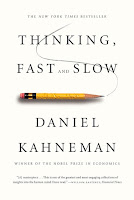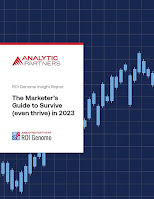Last month, I wrote an article here arguing that, to achieve success in 2023 and beyond, marketers will need to be adept at leveraging both the capabilities of technology and data science, and the principles of behavioral science describing how people make decisions. I called technology/data science and behavioral science the yin and yang of high-performance marketing.
Technology and data science have received a great deal of attention in marketing circles. For example, the use of artificial intelligence in marketing has been a hot topic in the industry for the past few years, and the recent tsunami of buzz surrounding ChatGPT and other generative AI applications has been nothing short of astounding.
The use of behavioral science in marketing has received somewhat less attention, even though marketers have been using principles of behavioral science for decades.
Given the importance of technology/data science and behavioral science for marketing, I'll be providing a reading list of the books I've found most useful for learning about these topics. I'll cover books relating to technology and data science in a future post. In this post, I'll describe the books that I think are required reading for marketers who want to leverage behavioral science principles in their marketing efforts.
The following list is by no means comprehensive, and most of the books listed aren't that new. However, these four books will give you a solid foundation in the principles of behavioral science that are relevant to marketing.
Here are my essential must-reads.
Thinking, Fast and Slow by Daniel Kahneman (Farrar, Straus and Giroux, 2011)
 |
| Source: Farrar, Straus and Giroux |
If you can only read one book about human thinking and decision making, it should be Thinking, Fast and Slow by Daniel Kahneman, one of the most influential psychologists in history, and the winner of the 2002 Nobel Prize in economics.
Kahneman can accurately be described as the intellectual "godfather" of behavioral economics. In the 1970's, he and fellow psychologist Amos Tversky collaborated on research regarding the non-rational aspects of human decision making. The work of Kahneman and Tversky laid the foundation for the behavioral science discipline we now call behavioral economics.
In Thinking, Fast and Slow, Kahneman asserts that the cognitive processes people use can be thought of as two "systems."
- System 1 (fast thinking) operates automatically, quickly, with little or no effort, and with no sense of voluntary control.
- System 2 (slow thinking) consists of thinking processes that are reflective, controlled, deliberative, and analytical.
When we think of ourselves, we identify with System 2, our rational self, but System 1 actually originates many of the impressions and feelings that are the sources of the explicit beliefs and deliberative choices of System 2. Therefore, System 1 exerts a powerful influence on the economic decisions we make, including decisions about the products and services we decide to buy.
The most important lesson for marketers in Thinking, Fast and Slow is that System 1 uses heuristics (mental shortcuts) to generate our impressions, intuitions, and feelings. Astute marketers can use these heuristics to make marketing messages and programs more effective.
 |
| Source: HarperCollins Publishers |
The original edition of Predictably Irrational was published in 2008, and this book, along with Nudge (discussed below), raised public awareness of behavioral economics and put it on the radar screens of business and marketing leaders.
In Predictably Irrational, Ariely described several experiments that illustrate the many invisible factors that lead us to think and behave in ways that are both irrational and predictable.
Ariely summarized the basic thesis of the book when he wrote:
"If I were to distill one main lesson from the research described in this book, it is that we are pawns in a game whose forces we largely fail to comprehend. We usually think of ourselves as sitting in the drivers seat, with ultimate control over the decisions we make and the direction our life takes; but, alas, this perception has more to do with our desires - with how we want to view ourselves - than with reality."
 |
| Source: Yale University Press |
The original edition of Nudge was published in 2008, and "nudging" soon became a popular behavior change/management tactic in both the public and the private sectors.
A key lesson for marketers in Nudge is the power of choice architecture, which describes how the arrangement and/or framing of choices or options can affect what choices are made and which option is selected. One example in the book discusses how the order in which food items are arranged in a school cafeteria can lead students to make more healthy eating habits.
 |
| Source: Kogan Page |
Thinking, Fast and Slow, Predictably Irrational, and Nudge aren't specifically about the role of behavioral science in marketing. But these books provide insights into human decision making that are essential for marketers to understand if they want to create effective marketing messages and programs.
Using Behavioral Science in Marketing speaks directly to how marketers can leverage principles of behavioral science to improve their marketing efforts.
Nancy Harhut clearly wrote this book for hands-on marketing practitioners. While she provides clear descriptions of the behavioral science principles discussed in the book, and ample citations to the research relating to those principles, her primary focus is on how marketers can apply those principles in real-world situations.
I wrote a review of
Using Behavioral Science in Marketing last fall, and I recommend that you
read that review to get a more complete description of this book.
Top image courtesy of Affen Ajlfe (www.modup.net) via Flickr (CC).












